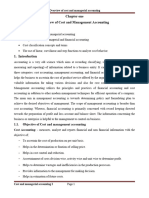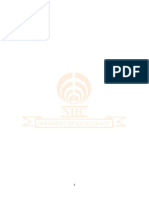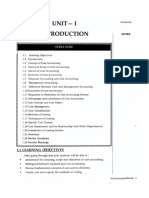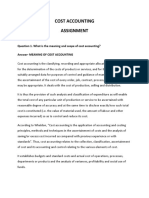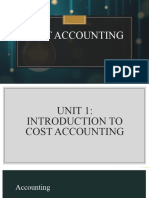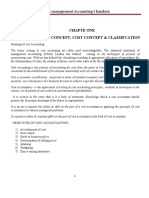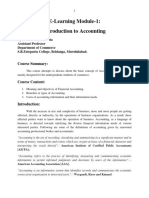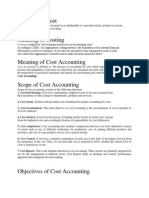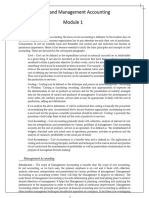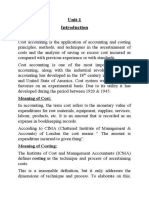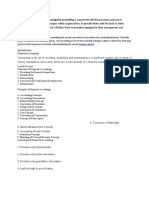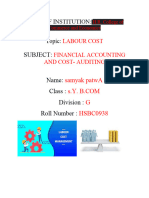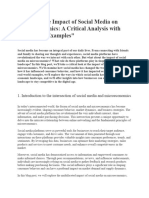MODULE 1 - INTRO
MODULE 1 - INTRO
Uploaded by
mdfdwwjvw6Copyright:
Available Formats
MODULE 1 - INTRO
MODULE 1 - INTRO
Uploaded by
mdfdwwjvw6Copyright
Available Formats
Share this document
Did you find this document useful?
Is this content inappropriate?
Copyright:
Available Formats
MODULE 1 - INTRO
MODULE 1 - INTRO
Uploaded by
mdfdwwjvw6Copyright:
Available Formats
F.Y.B.
com – Semester I – Cost Accounting [Academic Year 2024-25]
MODULE I : INTRODUCTION TO COST ACCOUNTING
INTRODUCTION:
Accounting provides information to a diverse group of people such as shareholders,
managers, creditors, tax authorities etc. On the basis of the purpose for which this
information is used, accounting is divided into three parts:
1. Financial Accounting
2. Cost Accounting
3. Management Accounting
Financial Accounting is mainly concerned with recording business transactions in
the books of accounts for the purpose of presenting final accounts to management,
shareholders and tax authorities. It consists mainly of Profit & Loss Account, Balance
Sheet and Cash Flow Statement.
Cost Accounting started as a branch of financial accounting. But with the increased
complexity of modern industry cost accounting gained importance as a separate
stream of accounting. It is concerned with the ascertainment of past, present and
future costs of products manufactured or services supplied. It is primarily developed
to meet the needs of the various levels of the management.
Management Accounting is concerned with all such accounting information that is
useful to management. It is mostly concerned with the provision of accounting
information for management activities such as decision making, planning and
controlling, etc.
MEANING OF COST, COSTING, COST ACCOUNTING AND COST ACCOUNTANCY:
Cost is the amount of resource given up in exchange of some goods or services. It
can be expressed as a noun as well as a verb. As a noun, it can be defined as the
amount of expenditure (actual or notional) incurred on or attributable to a specified
article, product or activity. As a verb, it can be as an action to ascertain the cost of a
specified thing or activity.
The Chartered Institute of Management Accountants (CIMA), London has defined
costing as “the techniques and processes of ascertaining costs.”
Thus costing simply consists of principles and rules which are used for determining:
a) the cost of manufacturing a product, e.g. motor car, furniture, chemical, etc.
b) the cost of providing a service, e.g. electricity, transport, education, etc.
Costing is simply determining costs by using arithmetical methods.
Cost Accounting on the other hand denotes the formal accounting mechanism by
means of which costs are ascertained by recording them in the books of accounts
using double entry system of accounting.
Cost Accounting is defined as "the process of accounting for cost which begins with
the recording of income and expenditure or the bases on which they are calculated
and ends with the preparation of periodical statements and reports for ascertaining
and controlling costs."
Cost Accountancy has been defined as “the application of costing and cost
accounting principles, methods and techniques to the science, art and practice of
cost control and the ascertainment of profitability. It includes the presentation of
information derived there from for the purpose of managerial decision making.”
SVKM’s NMIMS 1 | Page
F.Y.B.com – Semester I – Cost Accounting [Academic Year 2024-25]
Cost Accounting Vs Financial Accounting
Particulars Cost Accounting Financial Accounting
Definition Cost accounting is the art and Financial accounting is the act of
science of applying the costing classifying, storing, recording, and
methods, techniques, and principles analysing the financial transactions
to the products, projects, and of the company through financial
processes to improve the statements to improve profitability
profitability and to reduce the and to maintain the transparency
overall cost of the business. of the company.
Objective The main objective of cost The main objective of financial
accounting is to find out per unit accounting is to reflect the
cost of every product, process, or a accurate financial picture of an
project. organization to the external
stakeholders, toward whom the
organization is responsible.
Scope The scope of cost accounting The scope of financial accounting is
revolves around management and more pervasive; because it tries to
its decision making processes. It is disclose an accurate financial
more of an internal score than picture to its stakeholders.
outside reflection.
Estimation Cost accounting is based on the In financial accounting, the
comparison between the actual recording is always done on the
transaction and the estimation of actual transactions only. There’s no
cost of the transaction. place for estimation.
Particular Cost accounting isn’t done as per Financial accounting is done for a
period any particular period. Rather it’s particular financial period, which
calculated as per the requirement of generally starts on 1st April of the
the management decision making year and ends at 31st March of the
process. next year.
Reduction of Cost accounting serves two Financial accounting on the other
cost purposes. Firstly, it ensures that cost hand doesn’t concentrate on cost
of operations (or producing a control; rather its only purpose is
product) is reduced by setting up an to disclose the right information in
estimated cost for each unit of a an accurate way.
product. Secondly, cost accounting
reflects the true picture of
operations.
Tools / There are mainly three things that Financial accounting takes the help
Statements cost accounting ascertains – the cost of journal, ledger, trail balance, and
of sales of the product, how much financial statements such as
margin the organization would add, income statement, balance sheet,
and the selling price of the product. shareholders’ equity statement,
Of course, cost accounting is much and cash flow statement.
more than that, but these are the
essentials of cost accounting.
Measurement As cost accounting tries to find out Financial accounting shows the big
of efficiency the pixel view of operations, it is able picture of a company; as a result,
to provide a lot of information financial accounting isn’t able to
regarding the loopholes of labours improve the efficiency of the
and other inputs and also offers inputs.
valuable feedback to improve the
efficiency of the inputs.
SVKM’s NMIMS 2 | Page
F.Y.B.com – Semester I – Cost Accounting [Academic Year 2024-25]
OBJECTIVES AND FUNCTIONS OF COST ACCOUNTING:
1. Ascertainment of Cost: This is the primary objective of cost accounting. In cost
accounting, cost of each unit of production, job, process or department etc. is
ascertained. Not only actual costs incurred are ascertained but costs are also pre-
determined for various purposes. For cost ascertainment, various methods and
techniques are employed under different situations.
2. Cost control and cost reduction: Cost Accounting aims at improving profitability
by controlling and reducing costs. For this purpose, various specialized techniques
like standard costing, budgetary control, inventory control, value analysis, etc. are
used. This objective of cost control and cost reduction is becoming increasingly
important in the present scenario because of growing competition in the business
world.
3. Guide to business policy: Cost accounting aims at serving the needs of the
management in conducting the business with utmost efficiency. Cost data
provides guidelines for various managerial decisions like make or buy, selling
below cost, utilization of idle plant capacity, introduction of new product, etc.
4. Determination of Selling Price: Cost Accounting provides cost information on the
basis of which selling prices of products or services may be fixed. In periods of
depression, cost accounting guides in deciding the extent to which the selling
prices may be reduced to meet the situation.
ADVANTAGES OF COST ACCOUNTING:
The deficiencies of financial accounting may be stated as the advantages of cost
accounting because the latter has emerged to overcome the limitations of the
former. The principle advantages of cost accounting are as follows:
Advantages to the Management:
1. Reveals profitable and unprofitable activities: On the basis of the information
from cost records the management may take steps to reduce or eliminate
wastages and inefficiencies occurring in any form such as idle time, under
utilisation of plant capacity spoilage of materials, etc.
2. Helps in Cost Control: Cost accounting helps in controlling costs with special
techniques like standard costing and budgetary control.
3. Helps in decision making: It supplies suitable data and other related information
for managerial decision making such as introduction of a new product line,
replacement of old machinery with an automatic plant, make or buy, etc.
4. Guides in fixing selling prices: Cost is one of the most important factors to be
considered while fixing prices. A system of cost accounting guides the
management in the fixation of selling prices, particularly during depression
period when prices may have to be fixed below cost.
5. Helps in inventory Control: Perpetual inventory system, which is an integral part
of cost accounting, helps in the preparation of interim profit and loss account.
Other inventory control techniques like ABC analysis, level setting, etc are also
used in cost accounting.
SVKM’s NMIMS 3 | Page
F.Y.B.com – Semester I – Cost Accounting [Academic Year 2024-25]
6. Aids in formulating policies: Costing provides information that enables the
management to formulate production and pricing policies and preparing
estimates of contracts and tenders.
7. Helps in cost Reduction: It helps in the introduction of a cost reduction
programme and finding out new and improved ways to reduce costs.
8. Reveals idle capacity: A concern may not be working to full capacity due to
reasons such as shortage of demand, machine breakdown or other bottlenecks
in production. A cost accounting system can easily work out the cost of idle
capacity so that the management may take immediate steps to remedy the
position.
9. Checks the accuracy of financial accounts: Cost accounting provides a reliable
check on the accuracy of financial accounts with the help of reconciliation
between the two at the end of the accounting period.
10. Prevents frauds and manipulation: Cost audit system, which is a part of cost
accountancy, helps in preventing manipulation and frauds and thus reliable cost
data can be furnished to the management and others.
COST ACCOUNTING FRAMEWORK
Generally Accepted Cost Accounting Principles
Generally Accepted Cost Accounting Principles (GACAP) complied and issued by the
Institute of Cost Accountants of India, which may be relied as guiding principle and
practices for preparing cost records.
Cost Accounting Standards (CAS)
There are also standards i.e. Cost Accounting Standards (CAS) issued by Cost
Accounting Standards Board (CASB) of the Institute of Cost Accountants of India.
Cost Accounting Standards (CAS) issued to enable the management to take
informed decisions and to enable regulators to function more effectively by
Integrating, harmonizing, and standardizing cost accounting principles and practices.
Is it mandatory to follow CAS?
The Cost Accounting Standards will be mandatory from the respective date(s)
mentioned in the Cost Accounting Standard(s). The mandatory status of a Cost
Accounting Standard implies that while discharging their attest functions, it will be
the duty of the members (CMAs) of the Institute (ICAI, Kolkata) to examine whether
the Cost Accounting Standard is complied with in the preparation of the General
Purpose / Special Purpose Cost Statement which is required to be attested by the
Cost Accounting professionals wherever applicable.
As far as maintenance of cost accounting records under the Companies Act or
any other statute is concerned, relevant matter covered under the standards,
wherever applicable shall be followed. In the event of any deviation from the Cost
Accounting Standard, it will be their duty to make adequate disclosures in their cost
audit reports so that the users of cost statements may be aware of such deviation.
Cost Statements cannot be described as complying with the Cost Accounting
Standards unless they comply with all the requirements of each applicable Standard.
SVKM’s NMIMS 4 | Page
F.Y.B.com – Semester I – Cost Accounting [Academic Year 2024-25]
COST CONCEPTS AND CLASSIFICATIONS:
Meaning of cost: Cost is the amount if expenditure, actual or notional, incurred or
attributable to a given thing. (CIMA, London)
Meaning of expense: Expense is defined as an expired cost resulting from a
productive usage of an asset. In other words, an expense is that portion of the
revenue earning potential of an asset which has been consumed in the generation
of revenue. Unexpired or unconsumed cost is recorded as an asset in the balance
sheet. Such an unexpired cost is converted into an expense when it expires while
helping to earn revenue.
Meaning of Loss: Loss is defined as reduction in a firm’s equity, other than from
withdrawals of capital for which no compensation value has been received. A loss is
an expired cost resulting from the decline in the service potential of an asset that
generated no benefit to the firm.
Meaning of Cost Object: Cost object is anything for which a separate measurement
of cost is required. Cost object may be a product, a service, a project, a customer, a
brand category, an activity, a department or a programme etc.
Examples of cost objects are:
Product Smart phone, Tablet computer, SUV Car, Book etc.
Service An airline flight from Delhi to Mumbai, Concurrent audit
assignment, Utility bill payment facility etc.
Project Metro Rail project, Road projects etc.
Activity Quality inspection of materials, Placing of orders etc.
Process Refinement of crudes in oil refineries, melting of billets or ingots in
rolling mills etc.
Department Production department, Finance & Accounts, Safety etc.
Cost Units:
It is a unit of product, service or time (or combination of these) in relation to which
costs may be ascertained or expressed.
We may for instance determine the cost per ton of steel, per ton-kilometre of a
transport service or cost per machine hour. Sometime, a single order or a contract
constitutes a cost unit. A batch which consists of a group of identical items and
maintains its identity through one or more stages of production may also be
considered as a cost unit.
Cost units are usually the units of physical measurement like number, weight, area,
volume, length, time and value.
A few typical examples of cost units are as follows:
Industry or Product Cost Unit Basis
Automobile Number
Cement Ton / per bag etc.
Chemicals Litre, gallon, kilogram, ton etc.
Power Kilo-watt hour (kWh)
Steel Ton
Transport Passenger- kilometer
Gas Cubic feet
SVKM’s NMIMS 5 | Page
F.Y.B.com – Semester I – Cost Accounting [Academic Year 2024-25]
Some examples from the CIMA terminology are as follows:
Industry Sector Cost unit
Brewing Barrel
Brick-making 1,000 bricks
Coal mining Tonne/ton
Electricity Kilowatt-hour (kWh)
Engineering Contract, job
Oil Barrel, tonne, litre
Hotel / Catering Room / meal
Professional services Chargeable hour, job, contract
Education Course, enrolled student, successful student
Hospitals Patient day
Activity Cost unit
Credit control Accounts maintained
Selling Customer call, value of sales, orders taken
Materials storage / Requisition unit issued / received, material
handling movement, value issued / received
Personnel administration Personnel record
CLASSIFICATION OF COSTS
It means the grouping of costs according to their common characteristics.
The important ways of classification of costs are:
1) By Nature or Element
2) By Functions
3) By Variability or Behaviour
4) By Controllability
5) By Normality
6) By Costs for Managerial Decision Making
1) By Nature or Element: This type of classification is useful to determine the total
cost. A diagram as given below shows the elements of cost described as under:
ELEMENT OF COST
Material Cost Employee (Labour) Cost Other Expenses
Direct Material Indirect Direct Indirect Direct Indirect
Cost Material Cost Employee Employee Expenses Expenses
(Labour) Cost (Labour) Cost
Production Administration Selling and
Overheads Overheads
SVKM’s NMIMS 6 | Page
F.Y.B.com – Semester I – Cost Accounting [Academic Year 2024-25]
(i) Direct Materials: Materials which are present in the finished product (cost
object) or can be economically identified in the product are termed as direct
materials. For example, cloth in dress making; materials purchased for a specific
job etc. However, in some cases a material may be direct but it is treated as
indirect because it is used in small quantities, it is not economically feasible to
identify that quantity. Those materials which are used for purposes ancillary to
the business are also treated as Indirect Materials.
(ii) Direct Labour: Labour which can be economically identified or attributed wholly
to a cost object is termed as direct labour. For example, employee engaged on
the actual production of the product or in carrying out the necessary operations
for converting the raw materials into finished product.
(iii) Direct Expenses: All expenses other than direct material or direct labour which
are specially incurred for a particular cost object and can be identified in an
economically feasible way are termed as Direct Expenses. For example, hire
charges for some special machinery, cost of defective work etc.
(iv) Indirect Materials: Materials which do not normally form part of the finished
product (cost object) are known as indirect materials. Examples of indirect
material include:
Stores used for maintaining machines and buildings (lubricants,
cotton waste, bricks etc.)
Stores used by service departments like power house, boiler
house, canteen, etc.
(v) Indirect Labour: Labour cost which cannot be allocated but can be apportioned
to or absorbed by cost units or cost centres is known as indirect labour.
Examples of indirect labour includes salary paid to foreman and supervisors;
maintenance workers; etc.
(vi) Indirect Expenses: Expenses other than direct expenses are known as indirect
expenses. These cannot be directly, conveniently and wholly allocated to cost
centres. Examples of indirect expenses include Factory rent and rates, insurance
of plant and machinery, power, light,heating, repairing, telephone charges, etc.
(vii) Overheads: The aggregate of indirect material costs, indirect labour costs and
indirect expenses is termed as Overheads.
Overheads = Indirect material + Indirect labour + Indirect expenses
The main groups into which overheads may be subdivided are as
follows:
Production or Works Overheads: Indirect expenses which are incurred in
the factory and for the running of the factory. E.g.: rent, power etc.
Administration Overheads: Indirect expenses related to management and
administration of business. E.g.: office rent, lighting, telephone etc.
Selling Overheads: Indirect expenses incurred for marketing of a commodity.
E.g.: Advertisement expenses, commission to sales persons etc.
Distribution Overheads: Indirect expenses incurred for dispatch of the
goods E.g.: warehouse charges, packing(secondary) and loading charges.
“Your passion is waiting for your courage to catch up.”
SVKM’s NMIMS 7 | Page
F.Y.B.com – Semester I – Cost Accounting [Academic Year 2024-25]
2) By Functions: Under this classification, costs are divided according to the
function for which they have been incurred. It includes the following:
i) Direct Material Cost ii) Direct Employee (labour) Cost
iii) Direct Expenses iv) Production / Manufacturing Overheads
v) Administration Overheads vi) Selling & Distribution Overheads
vii) Research and Development costs etc.
Format of Cost sheet
Particulars Rs.
Direct Materials consumed # xxx
Direct Labour consumed xxx
Direct Expenses incurred xxx
Prime Cost xxx
Add: Factory / Works Overheads** xxx
Factory Cost or Works Cost xxx
Add: Administration Overheads** xxx
Cost of Production xxx
Add: Opening stock of Finished Goods xxx
Cost of Goods available for sale xxx
Less: Closing stock of Finished Goods xxx
Cost of Goods Sold xxx
Add: Selling and Distribution Overheads** xxx
Cost of Sales xxx
Add: Profit xxx
Sales xxx
# Opening stock of raw materials + Raw materials purchased – Closing stock of raw materials
**Overheads = Indirect Material + Indirect Labour + Indirect Expenses
3) By Variability or Behaviour: Based on this classification, costs are classified into
three groups viz., fixed, variable and semi-variable.
(a) Fixed costs: These are the costs which are incurred for a period, and which,
within certain output and turnover limits, tend to be unaffected by
fluctuations in the levels of activity (output or turnover). They do not tend
to increase or decrease with the changes in output. For example, rent,
insurance of factory building etc., remain the same for different levels of
production.
Fixed Cost
40000
35000
Cost (Rs.)
30000
25000
Fixed Cost
20000
15000
10000
0 100 200 300 400 500 600
Output (in units)
SVKM’s NMIMS 8 | Page
F.Y.B.com – Semester I – Cost Accounting [Academic Year 2024-25]
(b) Variable Costs: These costs tend to vary with the volume of activity. Any
increase in the activity results in an increase in the variable cost and vice-
versa. For example, cost of direct material, cost of direct labour, etc.
Variable Cost
60000
50000
Cost (Rs.)
40000
30000
20000
0 100 200 300 400 500 600
Output (in units)
c ) Semi-variable costs: These costs contain both fixed and variable
components and are thus partly affected by fluctuations in the level of
activity. Examples of semi variable costs are: Telephone bills, Gas and
electricity etc. Such costs are depicted graphically as follows:
Semi- Variable Cost
100000
Cost (Rs.)
80000
60000
40000
20000
100 200 300 400 500 600
Output (in units)
“Everything is hard before it is easy.”
4) By Controllability: Costs here may be classified into controllable and
uncontrollable costs.
(a) Controllable Costs: Cost that can be controlled, typically by a cost, profit or
investment centre manager is called controllable cost. Controllable costs
incurred in a particular responsibility centre can be influenced by the action of
the manager heading that responsibility centre. For example, direct costs
comprising direct labour, direct material, direct expenses and some of the
overheads are generally controllable by the shop floor supervisor or the
factory manager.
(b) Uncontrollable Costs: Costs which cannot be influenced by the action of a
specified member of an undertaking are known as uncontrollable costs. For
example, expenditure incurred by, say, the tool room is controllable by the
foreman in-charge of that section but the share of the tool-room expenditure
which is apportioned to a machine shop is not controlled by the machine
shop foreman.
SVKM’s NMIMS 9 | Page
F.Y.B.com – Semester I – Cost Accounting [Academic Year 2024-25]
Distinction between Controllable Cost and Uncontrollable Cost: The distinction
between controllable and uncontrollable costs is not very prominent and is
sometimes left to individual judgement. In fact, no cost is uncontrollable; it is
only in relation to a particular individual that we may specify a particular
cost to beeither controllable or uncontrollable.
5) By Normality: According to this basis, cost may be categorised as follows:
(a) Normal Cost: It is the cost which is normally incurred at a given level of
output under the conditions in which that level of output is normally
attained.
(b) Abnormal Cost: It is the cost which is not normally incurred at a given level
of output in the conditions in which that level of output is normally attained.
It is charged to Costing Profit and loss Account.
6) By Costs used in Managerial Decision Making: According to this basis, cost
may be categorised as follows:
(a) Pre-determined Cost: A cost which is computed in advance before produc-
tion or operations start, on the basis of specification of all the factors affecting
cost, is known as a pre-determined cost.
(b) Standard Cost: A pre-determined cost, which is calculated from
managements ‘expected standard of efficient operation’ and the relevant
necessary expenditure. It may be used as a basis for price fixation and for cost
control through variance analysis.
(c) Marginal Cost: The amount at any given volume of output by which aggregate
costs increases if the volume of output is increased or decreased by one unit.
(d) Estimated Cost: Kohler defines estimated cost as “the expected cost of
manufacture, or acquisition, often in terms of a unit of product computed on
the basis of information available in advance of actual production or
purchase”. Estimated costs are prospective costs since they refer to
prediction of costs.
(e) Differential Cost: (Incremental and decremental costs). It represents the
change (increase or decrease) in total cost (variable as well as fixed) due to
change in activity level, technology, process or method of production, etc. For
example, if any change is proposed in the existing level or in the existing
method of production, the increase or decrease in total cost or in specific
elements of cost as a result of this decision will be known as incremental
cost or decremental cost.
(f) Imputed Costs: These costs are notional costs which do not involve any
cash outlay. Interest on capital, the payment for which is not actually made, is
an example of imputed cost. These costs are similar to opportunity costs.
(g) Capitalized Costs: These are costs which are initially recorded as assets and
subsequently treated as expenses. Example, installation expenses on the
erectionof a machine are added to the cost of a machine.
(h) Product Costs: These are the costs which are associated with the purchase
and sale of goods (in the case of merchandise inventory). In the production
scenario, such costs are associated with the acquisition and conversion of
materials and all other manufacturing inputs into finished product for sale.
SVKM’s NMIMS 10 | Page
F.Y.B.com – Semester I – Cost Accounting [Academic Year 2024-25]
Under marginal costing, variable manufacturing costs constitute
inventoriable or product costs.
Under absorption costing, total manufacturing costs (variable and fixed)
constitute inventoriable or product costs.
(i) Opportunity Cost: This cost refers to the value of sacrifice made or benefit
of opportunity foregone in accepting an alternative course of action. For
example, a firm financing its expansion plan by withdrawing money from its
bank deposits. In such a case the loss of interest on the bank deposit is the
opportunity cost for carrying out the expansion plan.
(j) Out-of-pocket Cost: It is that portion of total cost, which involves cash
outflow. This cost concept is a short-run concept and is used in decisions
relating to fixation of selling price in recession, make or buy, etc. Out–of–
pocket costs can be avoided or saved if a particular proposal under
consideration is not accepted.
(k) Shut down Costs: Those costs, which continue to be, incurred even when a
plant is temporarily shut-down e.g. rent, rates, depreciation, etc. These costs
cannot be eliminated with the closure of the plant. In other words, all fixed
costs, which cannot be avoided during the temporary closure of a plant, will be
known as shut down costs.
(l) Sunk Costs: Historical costs incurred in the past are known as sunk costs.
They play no role in decision making in the current period. For example, in
the case of a decision relating to the replacement of a machine, the written
down value of the existing machine is a sunk cost and therefore, not
considered.
(m) Absolute Cost: These costs refer to the cost of any product, process or unit in
its totality. When costs are presented in a statement form, various cost
components may be shown in absolute amount or as a percentage of total
cost or as per unit cost or all together. Here the costs depicted in absolute
amount may be called absolute costs and are base costs on which further
analysis and decisions are made.
(n) Discretionary Costs: Such costs are not tied to a clear cause and effect
relationship between inputs and outputs. They usually arise from periodic
decisions regarding the maximum outlay to be incurred. Examples include
advertising, public relations, executive training etc.
(o) Period Costs: These are the costs, which are not assigned to the products
but are charged as expenses against the revenue of the period in which they
are incurred. All non-manufacturing costs such as general & administrative
expenses, selling and distribution expenses are recognised as period costs.
(p) Engineered Costs: These are costs that result specifically from a clear cause
and effect relationship between inputs and outputs. The relationship is
usually personally observable. Examples of inputs are direct material costs,
direct labour costs etc. Examples of output are cars, computers etc.
(q) Explicit Costs (out of pocket costs): These costs are also known as out-of-
pocket costs and refer to costs involving immediate payment of cash. Salaries,
wages, postage and telegram, printing and stationery, interest on loan etc.
are some examples of explicit costs involving immediate cash payment.
SVKM’s NMIMS 11 | Page
F.Y.B.com – Semester I – Cost Accounting [Academic Year 2024-25]
(r) Implicit Costs: These costs do not involve any immediate cash payment. They
are not recorded in the books of account. They are also known as economic
costs.
METHODS OF COSTING: Different industries follow different methods of costing
because of the differences in the nature of their work. The various methods of
costing are as follows:
Methods Description
Single or Under this method, the cost of a product is ascertained, the
Output product being the only one produced like bricks, coals, etc.
Costing
Batch This method is the extension of job costing. A batch may represent a
Costing number of small orders passed through the factory in batch. Each
batch here is treated as a unit of cost and thus separately costed.
Here cost per unit is determined by dividing the cost of the batch by
the number of units produced in the batch.
Job Costing Under this method of costing, cost of each job is ascertained
separately. It is suitable in all cases where work is undertaken on
receiving a customer’s order like a printing press, motor workshop,
etc.
Contract Under this method, the cost of each contract is ascertained
Costing separately. It is suitable for firms engaged in the construction of
bridges, roads, buildings etc.
Process Under this method, the cost of completing each stage of work is
Costing ascertained, like cost of making pulp and cost of making paper from
pulp. In mechanical operations, the cost of each operation may be
ascertained separately; the name given is operation costing.
Operating It is used in the case of concerns rendering services like transport
Costing sector, hotel industry, hospitals, etc.
Multiple It is a combination of two or more methods of costing outlined above.
Costing Suppose a firm manufactures bicycles including its components; the
parts will be costed by the system of job or batch costing but the cost
of assembling the bicycle will be computed by the Single or output
costing method. The whole system of costing is known as multiple
costing.
The following table summarises the various methods of costing applied in different
industries:
Nature of Output Method Cost Examples of
Industries
A Series of Processes Process costing or For each process Sugar
Operation Costing
Construction of building Contract Costing For each contract Real estate
Similar units of a Single Unit or output or For the entire Cold Drinks
Product, produced by Single Costing activity, but
Single Process averaged for the
output
SVKM’s NMIMS 12 | Page
F.Y.B.com – Semester I – Cost Accounting [Academic Year 2024-25]
Rendering of Services Operating Costing For all services Hospitals
Customer Specifications: Job Costing For each order / Advertising
single Unit assignment / Job
Consisting of multiple Multiple Costing Combination of Car Assembly
varieties of activities and any method
processes
TECHNIQUES OF COSTING
For ascertaining cost, following types of costing are usually used.
Techniques Description
Uniform When a number of firms in an industry agree among themselves to
Costing follow the same system of costing in detail, adopting common
terminology for various items and proc- esses they are said to
follow a system of uniform costing.
Advantages of such a system are:
i. A comparison of the performance of each of the firms can
be made with that of another, or with the average
performance in the industry.
ii. Under such a system, it is also possible to determine the cost of
production of goods which is true for the industry as a whole. It
is found useful when tax-relief or protection is sought from the
Government.
Marginal It is defined as the ascertainment of marginal cost by
Costing differentiating between fixed and variable costs. It is used to
ascertain effect of changes in volume or type of output on profit.
Standard It is the name given to the technique whereby standard costs are
Costing & pre-determined and subsequently compared with the recorded
Variance actual costs. It is thus a technique of cost ascertainment and cost
Analysis control. This technique may be used in conjunction with any
method of costing. However, it is especially suitable where the
manufacturing method involves production of standardised goods
of repetitive nature.
Historical It is the ascertainment of costs after they have been incurred.
Costing This type of costing has limited utility.
Post Costing: It means ascertainment of cost after production is
completed.
Continuous costing: Cost is ascertained as soon as the job is
completed or even when the job is in progress.
Absorption It is the practice of charging all costs, both variable and fixed to
Costing operations, processes or products. This differs from marginal
costing where fixed costs are excluded.
************************** ALL IZZ WELL ********************************
"Cost accounting is the backbone of a business;
It provides a detailed roadmap of where the money is being spent and how it can be saved."
SVKM’s NMIMS 13 | Page
You might also like
- The Corporate Credit Build Up GuideDocument49 pagesThe Corporate Credit Build Up GuideAnthony Vinson100% (3)
- Week8 Equity MKT 2: You Have CompletedDocument4 pagesWeek8 Equity MKT 2: You Have CompletedDerek LowNo ratings yet
- Auto Repair Shop Business PlanDocument40 pagesAuto Repair Shop Business PlanBelinda100% (5)
- Utility Smart BillDocument1 pageUtility Smart Billblackson knightsonNo ratings yet
- Module 1 Introduction To Cost AccountingDocument21 pagesModule 1 Introduction To Cost AccountingLeslie100% (1)
- Tax Reviewer 3 TRANSFER TAXDocument6 pagesTax Reviewer 3 TRANSFER TAXAlliahDataNo ratings yet
- Cost Accounting IntroDocument5 pagesCost Accounting Introblackeagle4445miNo ratings yet
- Chapter OneDocument15 pagesChapter OnefiraolmosisabonkeNo ratings yet
- 4 Sem Bcom - Cost AccountingDocument54 pages4 Sem Bcom - Cost Accountingraja chatterjeeNo ratings yet
- Theory Cost AccountingDocument11 pagesTheory Cost AccountingMrinmoy SahaNo ratings yet
- 2 Overview of Cost AccountingDocument18 pages2 Overview of Cost AccountingHarsh KhatriNo ratings yet
- HEI P U 0543 - SelfLearning - 20210723100028Document4 pagesHEI P U 0543 - SelfLearning - 20210723100028rbking15081999No ratings yet
- Cost and Management AccountingDocument52 pagesCost and Management Accountings.lakshmi narasimhamNo ratings yet
- Cost Accounting I Module AUC MT Final 1 - Finall (1) HandoutDocument71 pagesCost Accounting I Module AUC MT Final 1 - Finall (1) HandoutMOLALIGNNo ratings yet
- Cost AccountingDocument54 pagesCost Accountingnimisha vermaNo ratings yet
- COST ACCOUNTING NOTESDocument54 pagesCOST ACCOUNTING NOTESTalha ArshadNo ratings yet
- CH 1 PDFDocument10 pagesCH 1 PDFRajat PradhanNo ratings yet
- C&M Accounting Note of TheoriesDocument15 pagesC&M Accounting Note of TheoriesÃñjû GûptåNo ratings yet
- Cost & Management Accounting I Module PDFDocument185 pagesCost & Management Accounting I Module PDFPaulino211No ratings yet
- C-102 - 2022 - 1st - Class-01.11.2022Document29 pagesC-102 - 2022 - 1st - Class-01.11.2022touhiddewan2No ratings yet
- Cost Accounting AssignmentDocument15 pagesCost Accounting AssignmentDirector Telecom DoTNo ratings yet
- Cost AccountingDocument31 pagesCost Accountingnvenu7434No ratings yet
- Cost Accounting IDocument60 pagesCost Accounting Isamuel debebe50% (2)
- Af 211 Topic OneDocument17 pagesAf 211 Topic Oneamospeter295No ratings yet
- Cost AccountingDocument10 pagesCost AccountingFarhani Sam RacmanNo ratings yet
- Introduction To AccountingDocument7 pagesIntroduction To Accountingcarolaaquino27No ratings yet
- Week 1-Module 1: Overview of Cost Accounting I. Introduction To Cost AccountingDocument72 pagesWeek 1-Module 1: Overview of Cost Accounting I. Introduction To Cost Accountingtricia quilangNo ratings yet
- Acfn 2031 Cost & MGMT Acct (Final 2016)Document93 pagesAcfn 2031 Cost & MGMT Acct (Final 2016)maadiiahmed536No ratings yet
- Cost AccountingDocument22 pagesCost AccountingSiddharth KakaniNo ratings yet
- Cost and Management AccountingDocument181 pagesCost and Management AccountingFaithful nongerai100% (1)
- Cost & MGT Acct I Chapter OneDocument9 pagesCost & MGT Acct I Chapter OnefitsumNo ratings yet
- Deefrence Between Cost Accounting and Financial AccountingDocument4 pagesDeefrence Between Cost Accounting and Financial Accountingirshad.mbitsNo ratings yet
- Cost Accounting Importance and Advantages of Cost Accounting PapaDocument14 pagesCost Accounting Importance and Advantages of Cost Accounting PapaCruz MataNo ratings yet
- Meaning of CostDocument9 pagesMeaning of Costsanket8989100% (1)
- Cost Accounting1Document134 pagesCost Accounting1Ryan Brown100% (1)
- Cost Ac Notes BBAIIIDocument39 pagesCost Ac Notes BBAIIIbopob20461No ratings yet
- Course Code - 102 Course Title-Accounting For Business Decisions 2. Learning Objectives of The CourseDocument29 pagesCourse Code - 102 Course Title-Accounting For Business Decisions 2. Learning Objectives of The Courseavinash singhNo ratings yet
- Acc206 (Sms206) Ce&CsDocument50 pagesAcc206 (Sms206) Ce&Csmohammed.zekeri19No ratings yet
- MOD 1 - Introduction On Cost AccountingDocument10 pagesMOD 1 - Introduction On Cost Accountingzach thomasNo ratings yet
- Accounting Cost SheetDocument27 pagesAccounting Cost SheetMonika JainNo ratings yet
- Accounting For Business II PM Xii Chapter1Document27 pagesAccounting For Business II PM Xii Chapter1Senthil S. VelNo ratings yet
- Cost AccountingDocument27 pagesCost AccountingSaswat Nanda100% (1)
- CMA - Module 1 BKDocument13 pagesCMA - Module 1 BKvimalrparmar001No ratings yet
- Full Project KomulDocument106 pagesFull Project Komulmohan ks80% (10)
- Bba - Cost Management-Unit1Document19 pagesBba - Cost Management-Unit1Pridhvi Raj ReddyNo ratings yet
- COSTING Chapter 1 Basics of CostingDocument19 pagesCOSTING Chapter 1 Basics of CostingdepartmentofcommercepratibhaNo ratings yet
- Chapter One Introdutoin: 1.1. What Is Cost Accounting?Document156 pagesChapter One Introdutoin: 1.1. What Is Cost Accounting?NatnaelNo ratings yet
- Tools and Techniques of Cost ReductionDocument27 pagesTools and Techniques of Cost Reductionপ্রিয়াঙ্কুর ধর100% (2)
- Chapter 4.1 - Cost AccountingDocument14 pagesChapter 4.1 - Cost AccountingMehta Vani JogheeNo ratings yet
- Unit-1 Introduction Cost AccountingDocument23 pagesUnit-1 Introduction Cost AccountingShylaja NagNo ratings yet
- Course Title: Cost & Management Accounting Course Code:ACC 205Document37 pagesCourse Title: Cost & Management Accounting Course Code:ACC 205Ishita GuptaNo ratings yet
- Cost Accounting AssignmentDocument5 pagesCost Accounting AssignmentMargie Therese SanchezNo ratings yet
- Cost AccountingDocument70 pagesCost Accountingsriharsha5877454No ratings yet
- Management AccountingDocument20 pagesManagement AccountingPraveen KumarNo ratings yet
- CA-938-G-Samyak PatwaDocument23 pagesCA-938-G-Samyak Patwasamyak patwaNo ratings yet
- Cost CH IDocument5 pagesCost CH IheysemNo ratings yet
- Cost Accounting NotesDocument209 pagesCost Accounting Notescmacharia716No ratings yet
- Bba201 Management & Cost Accounting Unit 2Document24 pagesBba201 Management & Cost Accounting Unit 2Divya MishraNo ratings yet
- Cost AccountingDocument11 pagesCost AccountingPriyansh KhatriNo ratings yet
- The Balanced Scorecard: Turn your data into a roadmap to successFrom EverandThe Balanced Scorecard: Turn your data into a roadmap to successRating: 3.5 out of 5 stars3.5/5 (4)
- "The Language of Business: How Accounting Tells Your Story" "A Comprehensive Guide to Understanding, Interpreting, and Leveraging Financial Statements for Personal and Professional Success"From Everand"The Language of Business: How Accounting Tells Your Story" "A Comprehensive Guide to Understanding, Interpreting, and Leveraging Financial Statements for Personal and Professional Success"No ratings yet
- Financial Performance Measures and Value Creation: the State of the ArtFrom EverandFinancial Performance Measures and Value Creation: the State of the ArtNo ratings yet
- Summary Account Payable Statement: JiopayDocument10 pagesSummary Account Payable Statement: JiopayannuNo ratings yet
- Aufa Zarrar Luvian - 120110230024 - Ch.19 - Managerial AccountingDocument5 pagesAufa Zarrar Luvian - 120110230024 - Ch.19 - Managerial Accountingaufaluvian21No ratings yet
- Invoice: Page 1 of 3Document3 pagesInvoice: Page 1 of 3Prakash RoutNo ratings yet
- LNB Baler Activity DesignDocument6 pagesLNB Baler Activity DesignBarangay 4 San Luis AuroraNo ratings yet
- Law, Science and Ethics AssignmentDocument15 pagesLaw, Science and Ethics AssignmentRay AtienoNo ratings yet
- CHP 2 Market Forces Demand and Supply. Part I - CANVASDocument20 pagesCHP 2 Market Forces Demand and Supply. Part I - CANVAShimanshu varandaniNo ratings yet
- MR Statender Ganju Ji Full and Final Settlement PDFDocument1 pageMR Statender Ganju Ji Full and Final Settlement PDFchakshu220No ratings yet
- GX Audit Internal Audit Risk and Opportunities For 2022Document26 pagesGX Audit Internal Audit Risk and Opportunities For 2022Muhammad Sami100% (1)
- By Jamshaid Akhtar ACA: Events After Reporting PeriodDocument1 pageBy Jamshaid Akhtar ACA: Events After Reporting PeriodMuhammad AslamNo ratings yet
- Basic Concepts and Problems of Economics: Beeb 1013: Principle of Economics, Sem A171, Group Q Roslina KamaruddinDocument40 pagesBasic Concepts and Problems of Economics: Beeb 1013: Principle of Economics, Sem A171, Group Q Roslina KamaruddinFakhrul FahmiNo ratings yet
- 1 Comments On Research - IntroDocument7 pages1 Comments On Research - IntroLyka RoguelNo ratings yet
- Soal UAS Bahasa Inggris Profesi Semester Gasal 2023-2024 RegulerDocument2 pagesSoal UAS Bahasa Inggris Profesi Semester Gasal 2023-2024 Regulerdifakroisatul.22021100% (1)
- Strategic Analysis & Choice Topic 5Document48 pagesStrategic Analysis & Choice Topic 5venu100% (2)
- Operations Management Notes & Reviewer (Finals 1st Sem)Document11 pagesOperations Management Notes & Reviewer (Finals 1st Sem)Princess Delos SantosNo ratings yet
- Cost Acc. QuizDocument3 pagesCost Acc. QuizEki OmallaoNo ratings yet
- Atasha Lei Agcaoili Tle1 PDFDocument4 pagesAtasha Lei Agcaoili Tle1 PDFAtasha AgcaoiliNo ratings yet
- The Impact of Credit Management On Loan Default A Case Study of Ugafode Bank, Wandegeya BranchDocument24 pagesThe Impact of Credit Management On Loan Default A Case Study of Ugafode Bank, Wandegeya BranchOOGA TITUS PATRICKNo ratings yet
- Customs Power of Attorney-Company-2021Document1 pageCustoms Power of Attorney-Company-2021shahwaizNo ratings yet
- Major Project Report BbaDocument52 pagesMajor Project Report BbaSakshi SharmaNo ratings yet
- Levis BillDocument1 pageLevis Billआनंद चौबेNo ratings yet
- Study On Investor Behaviour in Systematic Investment Plan of Mutual FundDocument7 pagesStudy On Investor Behaviour in Systematic Investment Plan of Mutual FundSurajNo ratings yet
- Aikas - Timo BSCDocument65 pagesAikas - Timo BSCOladipo OlanyiNo ratings yet
- Chapter 2 - The Basics of Supply and DemandDocument24 pagesChapter 2 - The Basics of Supply and DemandSUMARTO SE, MENo ratings yet
- Strategic Purpose: Johnson, Gerry Whittington, Richard and Scholes, KevanDocument38 pagesStrategic Purpose: Johnson, Gerry Whittington, Richard and Scholes, KevanSusan LowNo ratings yet
- Unveiling The Impact of Social Media On MicroeconomicsDocument8 pagesUnveiling The Impact of Social Media On MicroeconomicsIvan MedićNo ratings yet







